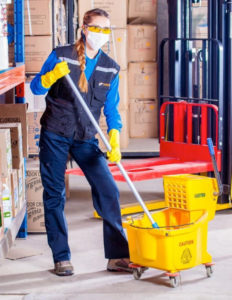Despite closures around the country due to the coronavirus outbreak, many warehouses continue to operate as essential businesses. For the health and safety of their workers and the continuity of their businesses, warehouses must implement stringent social distancing and cleanliness protocol to prevent coronavirus transmission in the workplace.
If your warehouse is operating during the coronavirus pandemic, these are necessary precautions to keep your employees safe.
Follow OSHA Guidance
OSHA has a number of resources for businesses operating during the pandemic. OSHA’s “Guidance for Preparing Workplaces for COVID-19” includes guidance such as:
- Encouraging sick workers to stay home.
- Ensuring access to handwashing stations and hand sanitizer.
- Increasing physical distance between employees and reducing the number of employees on-site.
- Implementing routine disinfection of equipment and surfaces.
- Increasing ventilation and air filtration.
- Identifying and isolating sick individuals and informing employees of possible exposure.
- Providing personal protective equipment (PPE) as appropriate.
You can find additional COVID-19 workplace resources here.
Consider a New Shift Pattern
One of the most common steps that warehouses have taken to increase the social distance between employees is staggering shifts. With fewer employees starting and leaving at once, it’s easier for employers to maintain social distance at time clocks, break rooms, and other common spaces. However, staggering start times may not be enough. Warehouses that require more drastic measures to maintain social distance between employees should look into different types of shift work patterns to decide what works best for their business.
Review Leave Policies
Employers want workers to stay home if they’re experiencing COVID-19 symptoms, but inflexible leave policies can make employees feel pressured to report to work even when they shouldn’t. To help employees feel secure in staying home, businesses should actively encourage sick employees to stay home and review sick leave policies to ensure they’re in line with public health guidance. Keep in mind that if your business doesn’t already provide two weeks of paid sick leave, it may be mandated to during the coronavirus pandemic. However, the expense is reimbursable through refundable tax credits.
Take Steps Toward a Safer Warehouse
Don’t limit your safety review to coronavirus-related concerns. As you make your warehouse a safer place to work, consider longer-term investments you can make into workplace safety.
- Invest in the right safety equipment: Face masks are getting a lot of attention during the COVID-19 outbreak, but there’s a lot more to warehouse safety equipment. Hardhats, safety glasses, and gloves should be provided to warehouse employees as appropriate. If workers provide their own, ensure spares are kept on hand.
- Review your control panel: Your industrial control panel is the heart and soul of your operations, but are you sure it meets all the necessary regulations and safety standards? Review your control panel’s schematic to ensure it’s compliant with regulatory standards. If it falls short, design an update to avoid putting workers at risk.
- Use appropriate signage and barriers: Whether a reminder to wear safety gear or a barrier blocking a loading dock, don’t underestimate the effectiveness of visual cues. Signage is a cost-effective way for businesses to improve safety and compliance.
- Train your staff: No amount of precaution can make up for poorly trained employees. Make sure your employees are an asset, not a risk, by investing in workplace training. Workers should understand common warehouse safety risks, proper usage of machinery, and how to report an accident. Instead of taking a one-and-done approach to training, make employee training a routine part of your business.
Whether your warehouse is experiencing a slump due to coronavirus or operating in overdrive, make sure you’re taking the right steps to keep your employees safe. While implementing new safety guidelines may place a burden on small, cash-strapped businesses, the impact of losing staff to illness is much greater. To keep your warehouse running through the pandemic and beyond, make safety a top priority.



